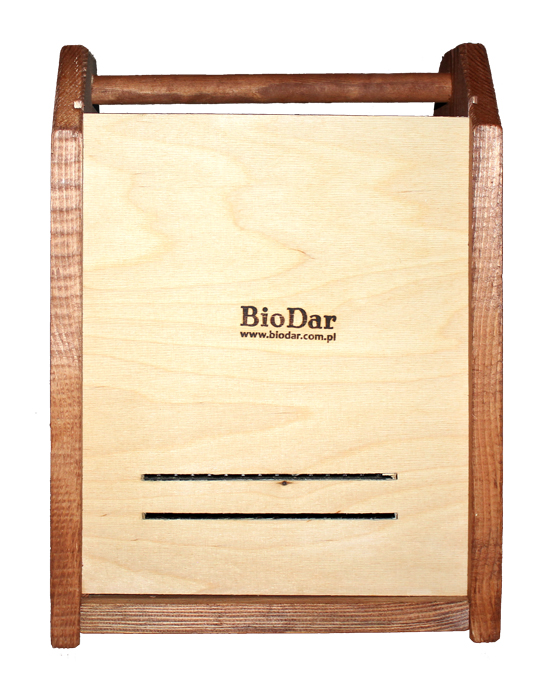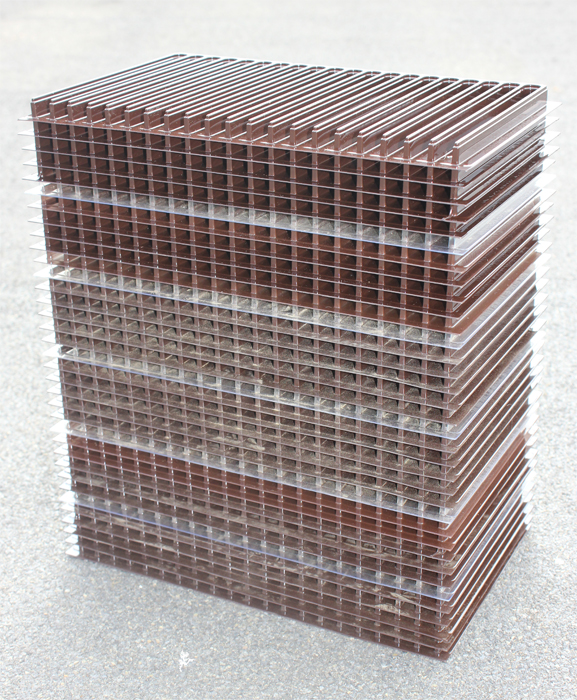Availability: Always on stock
Shipping time: Live organisms - minimum 2 weeks due to organisation of Veterinary Certificate
The cost of shipping: from 3,00 Euro
Create your own set for osmia rufa/bicornis breeding!
How to do it? - step by step instruction
1. How many mason bee cocoons do you need?
Warning!
Cocoons are only available during the sale period (usually October-April)
The next date of shipment containing cocoons: autumn 2024.
If you order cocoons remember:
2. How many nests do you need?
It can be assumed that 5 nesting trays are needed for every 100 cocoons.
Therefore, for example:
3. Casing - where to put the nests?
You have a choice:
The size should depend on the number of nests selected. You can also choose a larger casing if you plan to develop a mason bee breeding farm or you want to place a box with cocoons on the nesting trays, inside the casing.
Thus:
Hotel for insects, size S - can hold up to 20 nesting trays,
Hotel for insects, size M - can hold up to 35 nesting trays,
Hotel for insects, size L - can hold up to 50 nesting trays,
Nesting box - can hold up to 35 nesting trays.
This breeding set consists of:
Attention!
The set should be placed at any height, preferably not less than 1m from the ground, in a place providing protection against rain and wind, and the nesting box with trays must not be exposed to direct sunlight (high temperature during hot days may cause deformation of nesting trays and narrowing the nest channels)!
Achievements of the BioDar company enabled verification of the view about little importance of solitary bees in pollinating plants. As a result of long-term tests as well as constant improvement of constructed devices, there was namely introduced a complete and standardised system of breeding, which guarantees great effectiveness and ease of breeding mason and leafcutter bees (Megachilidae).
This innovative method makes possible acquiring the bees in an profitable way and in the same time maximally beneficial to their development. It was achieved thanks to limiting the most laborious activities, standardisation of the used devices and the use of materials accepted by these insects.

Complete breeding set consists of:
 The "hive" box with nesting trays constitute the body of the BioDar System. The box is built of wood, which is a durable, aesthetic and very well accepted by the bees material. Moreover, it has good acoustic and thermal insulation properties, positively influencing the course of biological processes in the nest arrangement. Maximum weight of the box with the nesting trays entirely filled up with food for larvae and with bees is not greater than 6.5 kg. The nesting boxes are secured with eco-friendly varnish, protecting them against climatic and habitat adverse conditions (great humidity, microbiological disintegration).
The "hive" box with nesting trays constitute the body of the BioDar System. The box is built of wood, which is a durable, aesthetic and very well accepted by the bees material. Moreover, it has good acoustic and thermal insulation properties, positively influencing the course of biological processes in the nest arrangement. Maximum weight of the box with the nesting trays entirely filled up with food for larvae and with bees is not greater than 6.5 kg. The nesting boxes are secured with eco-friendly varnish, protecting them against climatic and habitat adverse conditions (great humidity, microbiological disintegration).
 In the BioDar System all the aspects of the bee breeding economy are based on one key element, which is the nesting tray. This type of nesting arrangements was developed as a result of long-term tests and verified in field conditions. Using nesting trays is a novel solution and a step forward towards other nesting materials and manners of solitary bees breeding (see development works). A possibility of using the same nesting trays in many consecutive breeding seasons is a basic advantage.
In the BioDar System all the aspects of the bee breeding economy are based on one key element, which is the nesting tray. This type of nesting arrangements was developed as a result of long-term tests and verified in field conditions. Using nesting trays is a novel solution and a step forward towards other nesting materials and manners of solitary bees breeding (see development works). A possibility of using the same nesting trays in many consecutive breeding seasons is a basic advantage.
The nesting trays are made of thermoforming film used for food packaging production. This material is well accepted by bees, both at a stage of settling channels as well as transforming larvae into next developmental stages. The trays put together in a form of packages have two-ply sidewalls along the nest channels enabling temperature stabilisation inside the nests. The optimum length and the diameter of nest channels are adapted to the mason bee females requirements while laying eggs. Using the trays of the same dimensions during the whole breeding process makes possible the unification of the remaining equipment, which is an essential factor of the comprehensive development and the organization of the entire system.
The nesting trays offered by the BioDar company are legally protected (UP-RP/W.120675, DE 20 2013 000 232.8).
Basing on the long-term tests, we can assure you, that the BioDar company delivers general-purpose, long-lasting and handy nesting arrangements, with all labour-saving accessories, which render the bee breeding profitable and successful.
Lack of reviews for this product. Be the first to write a review.
Only registered customers can write reviews for products. If you have an account with us please log in to it, if you do not create a free account and write a review.